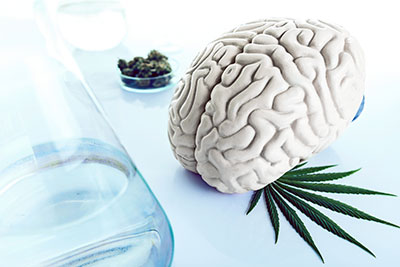Studies Tie Marijuana Use to Lasting Cortical Changes, Schizophrenia
Abstract
Two recent studies tied cannabis use to structural brain changes that remain visible on scans for years, as well as to behavioral changes and schizophrenia.

Use of marijuana during the teen years may cause accelerated thinning in a key developmental area of the brain, as well as attentional deficits. Meanwhile, cannabis use disorder (CUD) is contributing to a growing share of schizophrenia across populations, and young males appear to be particularly susceptible.
These are among the findings of two recent studies on cannabis use, both of which were named as 2023 Leading Research Achievements from the Brain and Behavior Research Foundation (BBRF), the world’s largest private funder of mental health research. The studies were issued as nearly half (44%) of young adults (aged 19 to 30) reported past-year use of marijuana, a U.S. record, and more than 1 in 10 (11%) reported daily use, the National Institute on Drug Abuse (NIDA) reported last August.
In the first study, initiation of cannabis in adolescence or young adulthood was associated with lasting changes in the brain’s cortex, an area that is not fully developed until the early 20s, according to a report by Matthew D. Albaugh, Ph.D., and colleagues in Molecular Psychiatry last June. The areas linked to cannabis use tended to vary based on the age at which cannabis use was initiated, researchers found.
Teen use of cannabis was associated with accelerated thinning primarily in the prefrontal cortex, a region critical for executive functioning, planning, and decision-making. Researchers also found that teen cannabis use was tied to past-month use of illicit substances, including cannabis, ecstasy, and cocaine, at age 22. Albaugh’s previous research tied the cortical thinning to attentional impulsivity (for example, inability to remain on task). Analysis showed that this thinning persisted into young adulthood and was still visible on participants’ magnetic resonance imaging (MRI) scans at age 22.
This foundational work is believed to be the largest longitudinal neuroimaging study to date examining the link between cannabis use by young people and brain development. The report dovetails work by Albaugh and colleagues published in JAMA Psychiatry in June 2021. For both studies, researchers tapped into a data set of nearly 800 European participants who were tracked for up to 10 years. Participants underwent MRIs at approximately ages 14, 19, and 22 and answered questionnaires about their behavior and substance use.

Using magnetic resonance imagining scans, Matthew D. Albaugh, Ph.D., led research tying teen use of cannabis with long-lasting, accelerated thinning in the prefrontal cortex, as well as to attentional impulsivity, and illicit substance use as a young adult.
“Historically there’s been little longitudinal research examining the effects of cannabis use,” Albaugh told Psychiatric News. He is an assistant professor of psychiatry at the Larner College of Medicine at the University of Vermont. “Many of the rules and regulations around minimum age and cannabis use seem to be based on rules governing alcohol, rather than solid empirical findings. With recreational cannabis use growing, we’re doing our best to better understand its impact on brain development and behavior, so individuals can make more informed decisions.”
Researchers found that the accelerated thinning occurred in brain areas that undergo the most change during adolescence and are also known to have, on average, a higher density of cannabinoid receptors, Albaugh said.
Meanwhile, initiating cannabis in early adulthood, between the ages of 19 and 22, was associated with brain changes in the temporal and cortical midline areas of the brain. These changes were tied to self-reported psychotic-like experiences, such as hallucinations.
“Some people seem to be less impacted from cannabis use than others,” Albaugh added. His continuing research aims to shed light on which factors might be at play in these differences, for example, genetic predisposition or particular psychopathology.
In his own clinical psychology practice, Albaugh has found that informing his young patients about the body of knowledge on the effects of cannabis use and letting them make their own decision is more helpful than lecturing them. He also works with his patients to track their own use of substances, along with their mood and anxiety symptoms, to help them better understand the connections.
CUD Tied to Schizophrenia
A study by Carsten Hjorthøj, Ph.D., and colleagues found strong evidence of a link between cannabis use disorder (CUD) and schizophrenia, among both men and women, according to a study of medical records for nearly 7 million people in Denmark. The records spanned five decades and included those of 45,000 people with schizophrenia.
Researchers found that men with CUD have a higher risk of schizophrenia than women, and young men face the highest risk, according to a May 2023 report in Psychological Medicine. In fact, young males aged 16 to 20 with CUD were twice as likely to develop schizophrenia as women with CUD. Using statistical models, researchers estimated that 15% of schizophrenia cases in men might be prevented if CUD was avoided. However, among young men aged 21 to 30, as many as 30% of cases of schizophrenia might be prevented.
Cannabis use disorder is not the primary driver of schizophrenia, yet researchers found that CUD is contributing to a steadily increasing share of cases over the past five decades. This is likely due to increases in the THC content of cannabis, global legalization, and prevalence of diagnosed CUD over time, authors noted.
In the past decade, access to cannabis has rapidly increased. In fact, three-quarters of Americans (74%) live in a state where marijuana is now legal for recreational or medical use, according to an analysis in February by the Pew Center. Four out of five Americans live in a county in which there is at least one legal cannabis dispensary.
According to the National Institutes of Health, each year about 100,000 U.S. adolescents or young adults experience first episode psychosis. “The entanglement of substance use disorders and mental illnesses is a major public health issue, requiring urgent action and support for people who need it,” said NIDA Director and study coauthor Nora Volkow, M.D. “As access to potent cannabis products continues to expand, it is crucial that we also expand prevention, screening, and treatment for people who may experience mental illnesses associated with cannabis use.”
Hjorthøj wrote that the current study may have implications beyond public policy and underscores “the need for clinicians to proactively screen for and diagnose CUD and schizophrenia and deliver sex-specific, high quality, and patient-centered care.”
Albaugh’s study was funded by the European Union, the National Institute of Health, and others listed at the end of the study. Hjorthøj’s study was led by researchers at the Mental Health Services in the Capital Region of Denmark and NIDA. It received no funding. ■



